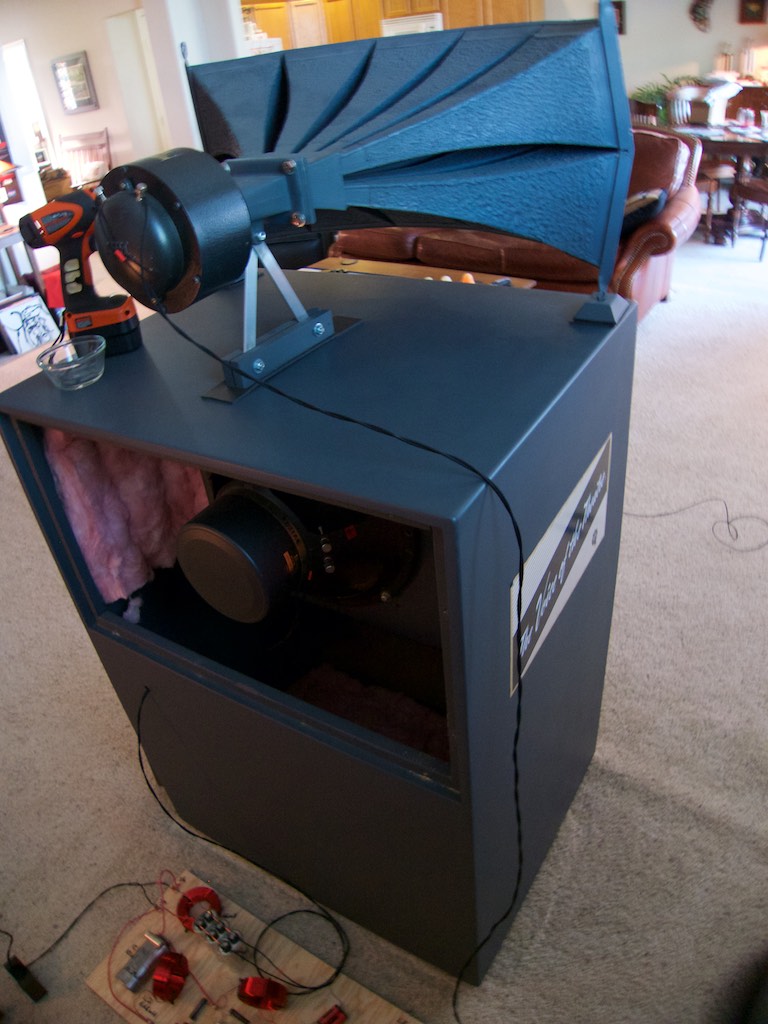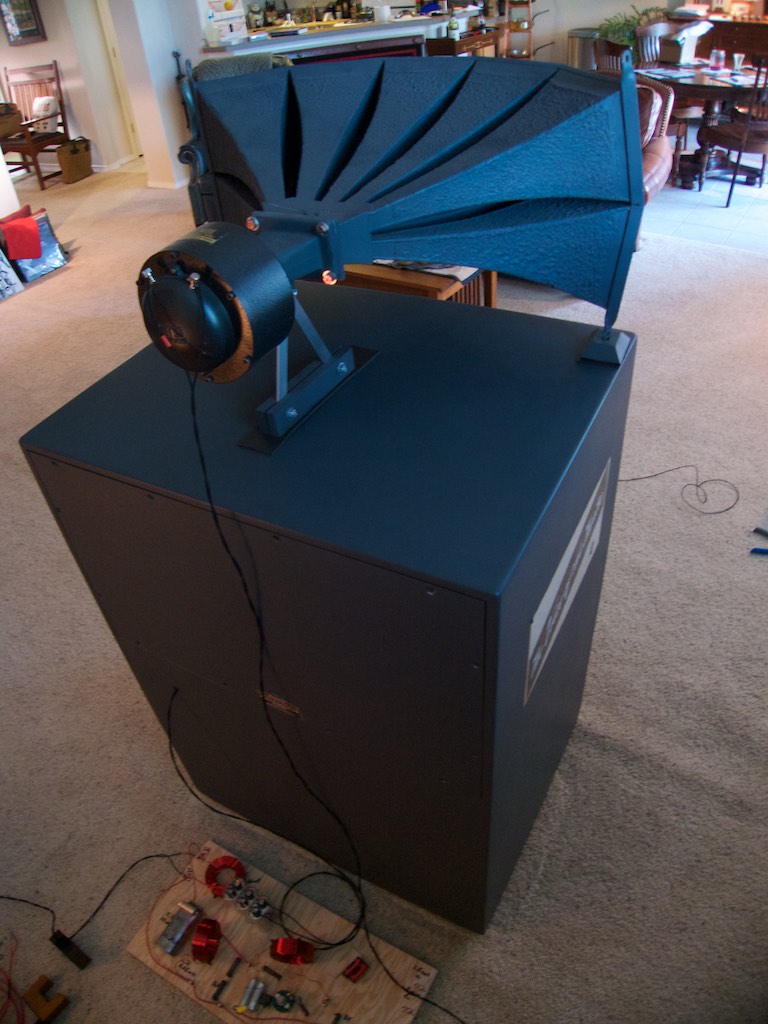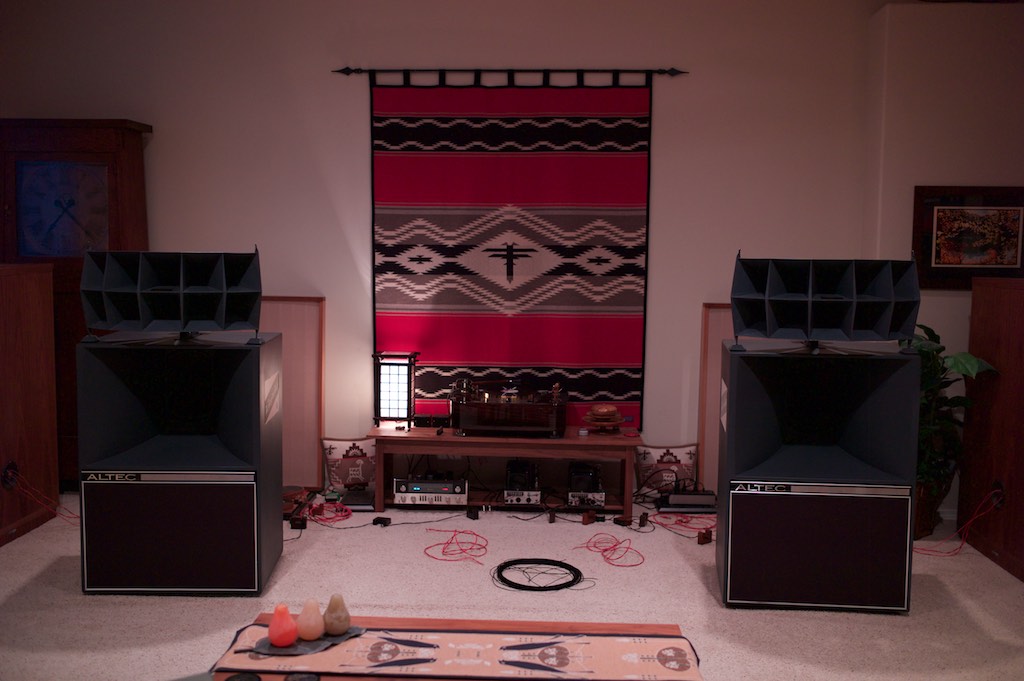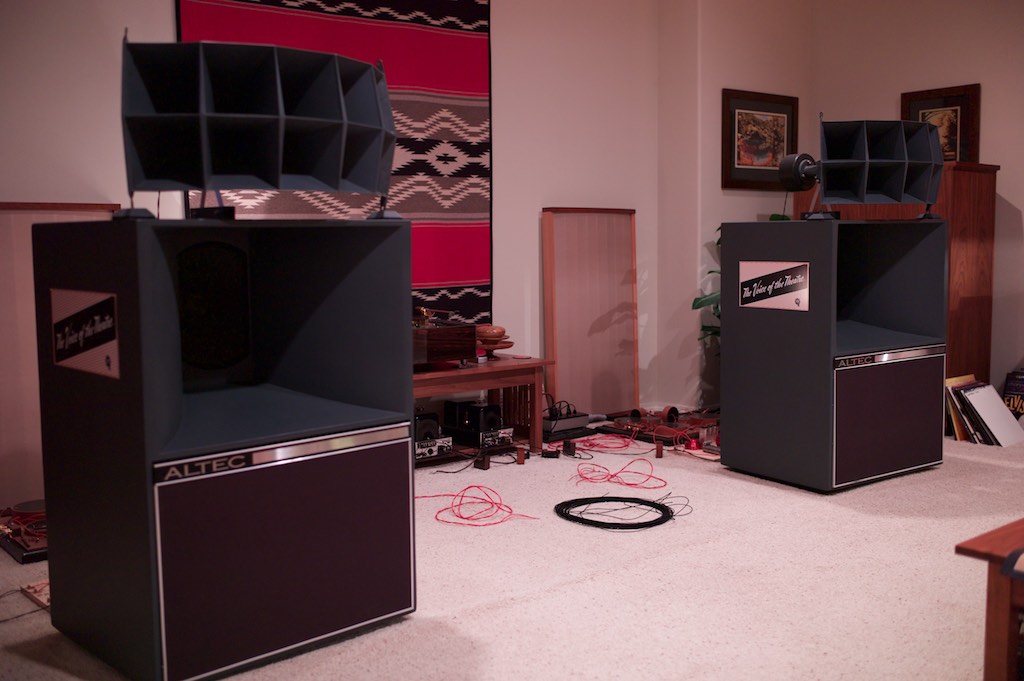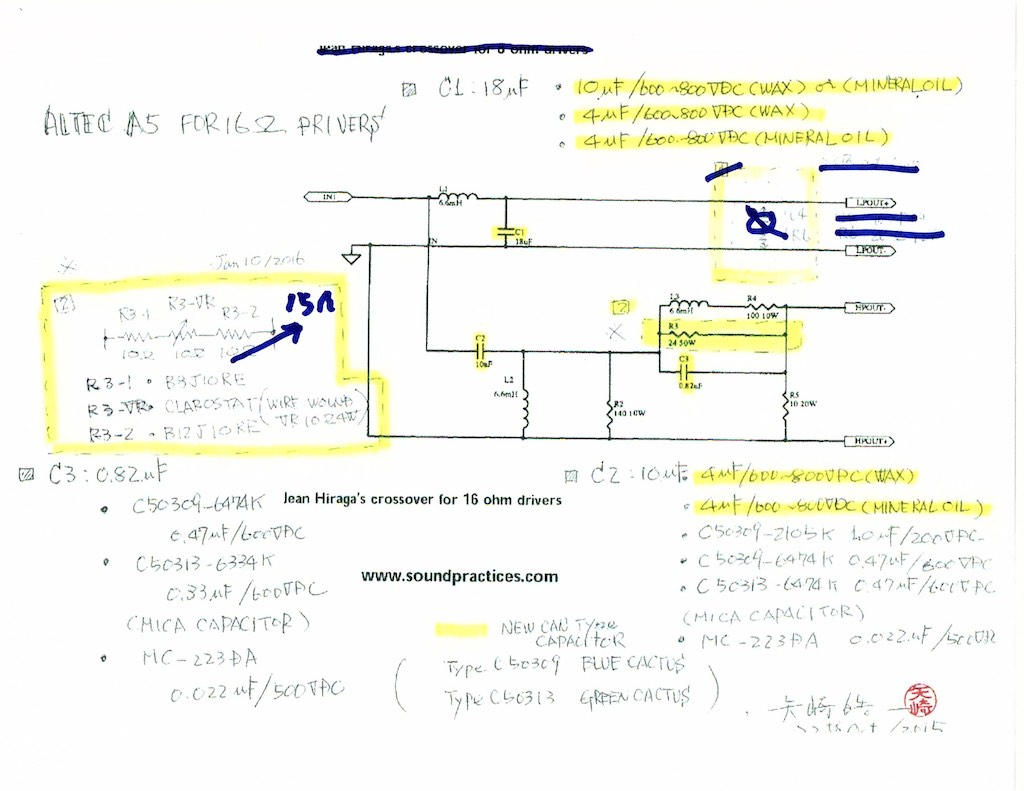After writing my last post, I got all excited about wiring up my A5 VOTT's Altec 16 Ohm 515B Alnico drivers in the 825B bass horns with Duelund DCA16GA wire.
First I removed the backs of the Altec 825B bass horns so I could get at the 16 Ohm 515B Alnico drivers, and then removed the vintage Western Electric WE16GA wire that goes from the low-frequency section of the crossover to the 16 Ohm Altec 515B Alnico drivers.
I set the precious vintage Western Electric WE16GA aside, giving thanks for its musical contribution to my life, and then cut 4 equivalent lengths of the Duelund DCA16GA.
Because the Duelund DCA16GA is all black I cut small lengths of red Peavey microphone tape to mark each end of the + runs, then I trimmed off enough dielectric to expose the wire ends so that I could connect them to the drivers and low-frequency crossover circuit.
After getting the Duelund DCA16GA installed onto the Altec 16 Ohm 515B Alnico drivers, routing it through the 825B bass horns and out to the crossovers, I then put the backs on and fired up my vintage McIntosh gear and let everything warm up for a while on NPR to make sure everything was working ok, and that I hadn't mis-wired anything.
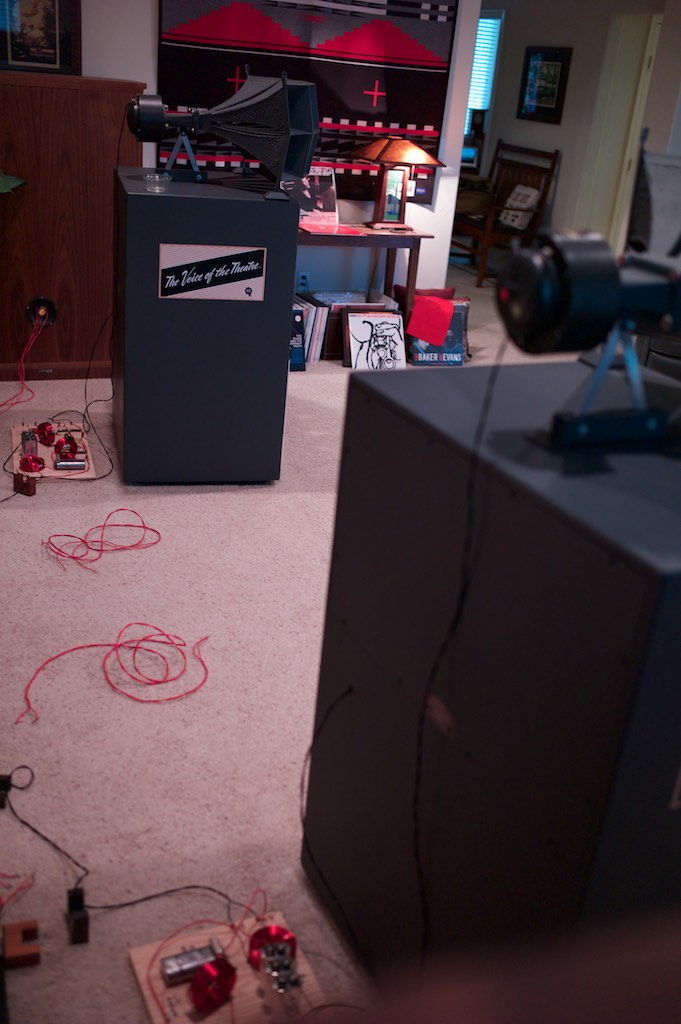
My A5's with DCA16GA now on both the Altec 515B & 288C drivers. Lonely WE16GA that was removed sitting between the speakers.
After making sure everything was wired up right and functioning properly I listened to classical music on NPR for a while, and liked what I was hearing.
The next step is to get out some vinyl and see what happens. I am keeping an open mind as I need to get the requisite 100 hours of run-in time on the Duelund DCA16GA before I make any conclusions.
***
Update Tuesday September 6th: The 10-hour point.
I've now got about 10 hours on the Duelund DCA16GA that I wired my Altec A5's 515B low-frequency drivers with. What's happened in that time has been interesting, and a little bit unusual, so I thought you'd like to hear more about it.
First of all I should mention that the Duelund DCA16GA RCA interconnects I built back on August 28th are installed between my vintage McIntosh MX110 tuner-preamplifier and my vintage McIntosh MC30 monaural amplifiers, and I have no desire to take them out of the system. In fact, I now want to build another pair of RCA interconnects with the Duelund DCA16GA to go from my Intact Audio SUT (for my Ortofon SPU Classic GM Mk II stereo cartridge) to my MX110, just to see what happens.
Here's what I said about the 2-meter Duelund DCA16GA interconnects after they got a little time on them, "The overall presentation is warmish, beautifully musical, a little bit dark, but with a surprising amount of transparency and detail resolution, and with a vibrant presentation of tone color and musical nuance that seems to me to be the aural equivalent of a cinematic landscape of Technicolor. Very impressive!"
As I chronicled my very first impressions of running the DCA16GA as single-run speaker cables from my MC30 amps to the Altec A5's crossovers, back on July 20th, I said, "What did I hear? Well, compared to the Western Electric WE16GA, from the Duelund DCA16GA I heard an overall richer presentation, a bit darker, smoother, more spacious, more timbrally colorful, with images having more presence, and superb portrayal of tempos, melodies, rhythm, and dynamics. Essentially, I heard everything that I really like about the Western Electric WE16GA, but everything was better. Everything, musically & sonically."
My impressions of the Duelund DCA16GA as RCA interconnects and speaker cables were similar in comparison to the Belden 8402 microphone cable interconnects, and Western Electric WE16GA, respectively, and to sum up, the Duelund DCA16GA was warmer, richer, more transparent, more timbrally colorful, and well, just more musical.
But here's where some of the unusual starts to come in to play. On July 29th I had wired the Duelund DCA16GA into the system from my Altec A5 VOTT's breadboard crossovers to the Altec 288C Alnico high-frequency compression drivers & Altec 1005B 10-cell horns combination.
I said, "Unlike the DCA16GA used as speaker cables (warm & rich right off the bat), the DCA16GA from the breadboard crossovers to the Altec 288C & 1005B combo behaved just like the Western Electric WE16GA, in that it sounded a little rough at first, the way tinned-copper conductors usually do, before settling down into that familiar Western Electric WE16GA-like musical wonderfulness."
To elaborate a little more, initially the Duelund DCA16GA sounded more like the Western Electric WE16GA did at first, a little rough & brash, and if anything, a little bit leaner & brighter. In other words it was the exact opposite of what I heard from it when used as interconnects & speaker cables. That's unusual. I would have expected it to have similar traits regardless of where I used it, but it didn't. Like the Western Electric WE16GA, the Duelund DCA16GA finally settled down and sounded rich, colorful, transparent, and just generally gorgeous and musical.
So as I started to tell you, I've now got about 10 hours on the Duelund DCA16GA that I wired my Altec A5's 515B low-frequency drivers with, and guess what? The Duelund DCA16GA going from my Altec A5's breadboard crossovers' low-frequency circuit to the 515B low-frequency drivers sounded a little rough & brash, a little bit leaner & brighter, just like it did when going from the breadboard crossovers' high-frequency circuit to the Altec 288C & 1005B combo. That's unusual.
I've been puzzling over this little conundrum, wondering why there would be a difference. I'd love to hear your ideas on it. The good thing is that after about 10 hours of run-in time things are settling down nicely, and sounding richer, more colorful, transparent, and just generally more gorgeous and musical.
I find wires with tinned-copper conductors to be intriguing, perplexing, and ultimately the most musical approach to hi-fi wiring I've come across. The trick is you have to give them plenty of run-in time to get their full measure of performance, like a 100 hours to fully get what they're capable of. If you remove them from the system they'll punish you for being so crass, and it'll take them a fair amount of time to settle back down to their musical best, which makes reviewing them challenging and a little bit frustrating. I've found I'm better off just not touching them after they're installed, waiting for them to completely settle in.
Having said all that, my vintage McIntosh & Altec A5 Voice of the Theater loudspeakers system has never sounded so musically compelling as it does right now with the Duelund DCA16GA wire making the connections.
Suffice it to say, that for those of you who appreciate 'vintage tone', 'real sound', and just gorgeous musicality, like I do, I think you'll love the Duelund DCA16GA in your system.
Again, I'd like to say a big "Thank you!" to Frederik for producing the Duelund DCA16GA, which is in fact a better 'vintage tone' cable than even the venerable Western Electric WE16GA, which I've been using now since Yazaki-san introduced me to it over a year ago.
The Duelund DCA16GA is a modern masterpiece in the tradition of the Western Electric WE16GA, and I feel really fortunate to have it in my system.
Ok, I've got to go, but I just wanted to give you a little snapshot of what's going on as I experiment with the Duelund DCA16GA, and I'll report back with some more detailed impressions shortly. From what I can tell, the Duelund DCA16GA has a lot more to give as it gets more time on it, and I'll be looking forward to telling you all about it.
Update: Saturday morning September 10th
I've been up early writing on my upcoming review for Positive Feedback of the Woody SPU tonearm by Pete Riggle Audio Engineering, then I put some caps on my audiodharma Cable Cooker to condition for a while, then I want to try them in Altec A7 Voice of the Theatre project crossovers.
Then I got the sudden urge to build another pair of RCA interconnects out of the Duelund DCA16GA cable to run from my Intact Audio custom SUT for my Ortofon SPU Classic GM MkII phono cartridge to my vintage McIntosh MX110Z tuner-preamplifier.
So I got out the soldering iron and soldered up a 1-meter pair of interconnects. Out came the Belden 8402 microphone cable interconnects and in went the Duelund DCA16GA interconnects.
Even with no run-in time the Duelund DCA16GA interconnects had gorgeous tone, but ... in this position their unshielded nature means they hum. My Belden 8402's also hum, but not nearly as much. The Belden's probably wouldn't hum at all if I had them wired conventionally, where only one end of the shield goes to ground, but then they wouldn't sound as musical either.
I can live with the amount hum coming from the Belden 8402's, but I am still undecided about the Duelund's. I should mention that with the Duelund DCA16GA 2-meter interconnects that connect my vintage Mac MX110Z to the MC30 monaural amps, there is zero hum.
The Duelund DCA16GA tone as interconnects sure is gorgeous though, so maybe I'll learn to live with it!
Update: Sunday Afternoon September 11th
As gorgeous as the tone was with the Duelund DCA16GA interconnects from my SUT to the MX110Z, I ended up taking it out of the system this afternoon because the hum level was just too high. I put the Belden 8402 microphone cable interconnects back in and was reminded about how wonderful it is as an interconnect.
I haven't given up on the Duelund DCA16GA as an interconnect from my SUT to my MX110Z yet, but I'll have to investigate some shielding. I notice that Parts Connexion has some ConneX tinned-copper braid shield so I'll investigate that as a solution to see if I can get the DCA16GA quieted down enough to use on my SUT.
Update: Sunday Afternoon September 11th on the A5 Voice of the Theatre Project:
I tried some 15 Ohm Brown Devil resistors this morning in the R3-2 position of my A5 crossovers (the Yazaki-san modification '2' of the Hiraga-san inspired crossover), which I think is a better match to the higher sensitivity of the 1005 horns, as compared to the 1505 horns that the Hiraga-san circuit was designed for.
The 15 Ohm Brown Devils were a noticeable improvement, making the A5's sound more balanced top-to-bottom, resulting in a richer overall tonal balance.
I'm still maxed out on resistance for the R3-1 - R3VR - R3-2 combination with the 15 Ohm Brown Devils, with the Clarostats turned all the way up, for a total resistance of 35 Ohms. So to give myself some adjustment range using the Clarostats, I think I'll go to 20 Ohm Brown Devil resistors in R3-2 next, and see if that allows me to do a little more fine tuning to the high-frequency circuit of the crossovers using the Clarostat variable resistors.
I've got another C3 capacitor combination cooking on my audiodharma Cable Cooker that I want to try, so I'll report back on that.
Update: Sunday Afternoon on the A5 VOTT Project
I have been using the combination of an Arizona Capacitor 0.47 uF Blue Cactus, Arizona Capacitor 0.33 uF Green Cactus, and a 0.022 uF Spec Ruby Mica to give me the C3 0.82 uF for my Hiraga-san inspired high-frequency crossover, and I thought it sounded pretty good. The only downside was that combination of caps lacked the last little bit of richness and smoothness that I desired from my 1005B 10-cell horns & 288C Alnico high-frequency compression drivers, so I had been pondering what to try next.
I had such good luck with Jupiter Condenser's Red Astron tinfoil capacitors in my MX110Z tuner-preamp - they were the only caps that I didn't immediately want to remove when compared to the vintage Sprague Bumblebee tone caps - that I thought I'd order some for my A5's crossovers to try.
Jupiter Condenser describes them thusly: "This phenolic case potted tinfoil and mylar capacitor yields a uniquely vintage tone perfect for guitar amplifiers and vintage audio amplifiers alike."
They're not kidding either, they have that familiar 'vintage tone' that those of you who use Western Electric WE16GA, Duelund DCA16GA, and Belden 8402 microphone cable interconnects would recognize right away.
So I ordered pairs of 0.33 uF & 0.47 uF Red Astron's to try in C3, but knowing that tin can be a bit fussy until it runs in, I gave them a couple days of run-in time on my audiodharma Cable Cooker to whip them into shape.
I really like what I'm hearing from the tinned-copper conductors in the Duelund DCA16GA, for example, so I thought I'd try some 'tinned-copper' capacitors in C3. Well, I don't have tinned-copper capacitors, but I had the Jupiter Condenser Red Astron's (tin) and the Arizona Capacitor's Blue Cactus (copper) that I could build composite tin-copper capacitors out of.
I combined an Arizona Capacitor 0.47 uF Blue Cactus, a Jupiter Condenser 0.33 uF Red Astron, and a 0.022 uF Spec Ruby Mica capacitor, but the combo came up about 0.02 short of the desired 0.82 uF when I measured it on the LCR meter, so I added in another 0.022 uF Spec Ruby Mica to top of the tank.
So I put together two pairs (one for each channel) of Arizona Capacitor 0.47 uF Blue Cactus', Jupiter Condenser 0.33 uF Red Astron's, and two 0.022 uF Spec Ruby Mica capacitors for my C3 experiment.
Out came the C3 combo of Arizona Capacitor 0.47 uF Blue Cactus, Arizona Capacitor 0.33 uF Green Cactus, and a 0.022 uF Spec Ruby Mica, and in went my new 'tinned-copper' caps.
Right of the bat I really liked the tonal balance of this combination for C3, as it added in the additional richness and smoothness I was looking for from my 1005B 10-cell horns & 288C Alnico high-frequency compression drivers, and at least at this point, there's no down side that has revealed itself. Success!
More to come.
As always, thanks for stopping by, and may the tone be with you!





